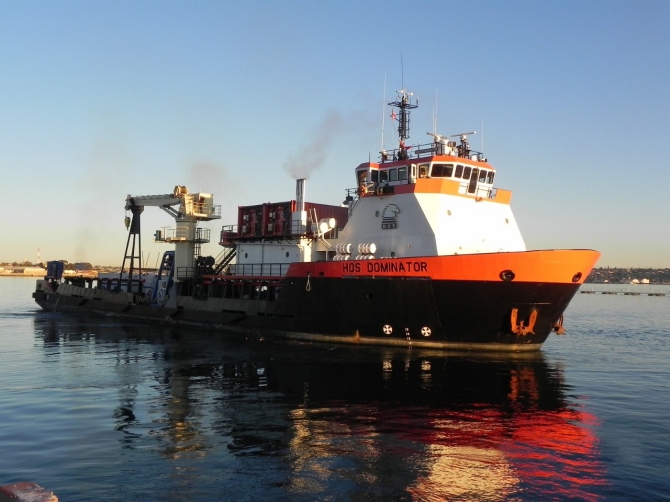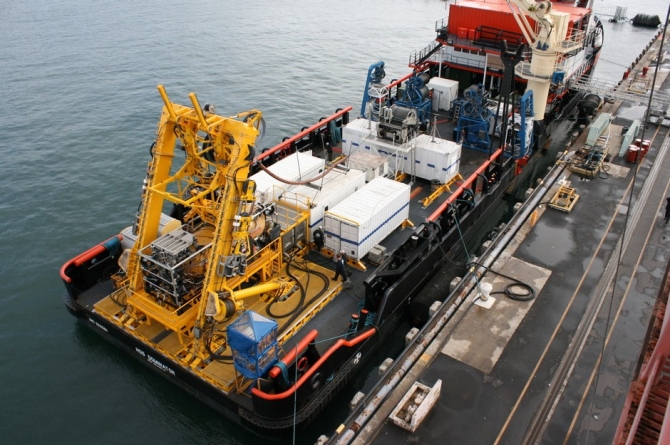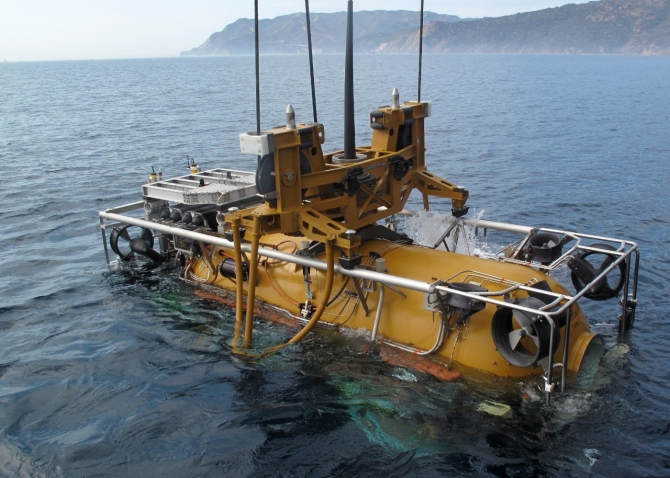Dominator (T-ARC-1)
The first U.S. Navy ship named Dominator.
(T-ARC-1: displacement 3,655; length 240'; beam 54'; armament none; class Dominator)


The MSC charters Dominator from Hornbeck Offshore Services, Inc., to support submarine and special warfare requirements.
On 19 July 2015, crewmembers from Undersea Rescue Command (URC) and contractors from Phoenix Holdings International (Phoenix) completed an operational readiness evaluation, re-certifying the Navy’s deep sea submarine rescue capability. The submarine rescue system had undergone an extensive refurbishment period. The evaluation, a component of crew certification, marked the final step in a multistage process that enabled the URC-Phoenix team to become rescue-ready for worldwide submarine rescue.
“This was a tremendous effort by our rescue team,” Capt. Eugene Doyle, commander, Submarine Squadron (SubRon) 11, who was responsible for the administrative and operational oversight of URC, explained, “Naval Sea Systems Command (NavSea), and Commander, Submarine Force U.S. Pacific Fleet in restoring this unique capability. Whether it’s a U.S. submarine, or a partner nation submarine, URC is ready to respond if called upon.”
The Submarine Rescue Diving and Recompression System (SRDRS), operated by URC-Phoenix, provided a last line of defense for the rescue of a submarine crew. Pressurized rescue module Falcon (PRM-1), a submarine rescue vehicle component of the SRDRS, was designed to dive to depths of up to 2,000 feet, and mate with a disabled submarine trapped on the sea floor. Airlifters could fly the SRDRS anywhere in the world to rescue submariners in distress.
Restoring Falcon comprised the initial effort of the overall re-certification process, at Portsmouth Naval Shipyard, Va., from February 2013–February 2014. The URC-Phoenix team then completed the vehicle’s final restoration.
“Without [Phoenix’s] diligent and exhaustive work assembling the PRM [Falcon] and their exemplary operations,” Cmdr. Andrew Kimsey, commanding officer of URC summarized, “we would not have been able to conduct sea trials. URC working alongside Phoenix was certainly key in getting past this big first step.” By late summer of 2014, URC and SubRon 11 began a very deliberate re-certification process with NavSea’s assistance. While the squadron and undersea command focused on qualifying and re-certifying their people, NavSea ensured that they met material re-certification standards.
“The URC and Phoenix personnel went through a rigorous multistage evaluation process known as crew certification,” Cmdr. John Doney, SubRon 11’s deputy commander for undersea rescue, said. “Phase One is an intensive administration review, making sure the crew’s training, qualification, material, quality assurance, and internal monitoring programs were up to standards and would allow for safe, worldwide deployable operations.”
The crew then began the operational certification process with Phase Two, which took place pierside on board Dominator, that functioned as their rescue system mother ship. The two-day event ran from the safety of being pierside and involved progressing the watch teams through live evolutions and drills utilizing the installed SRDRS equipment. “This event marked the first time the U.S. Navy submerged the PRM in the ocean since its overhaul and was an important step closer to our goal of deep sea diving,” Doney observed.
Meanwhile, NavSea’s dock and sea trials testing ensured that the deep rescue system operated materially as designed. Key milestones during sea trials included three deep dives, the first of which was an unmanned 2,000-foot dive to verify hull and component integrity at the crushing depth of 61 atmospheres absolute — which is more than 900 pounds per square inch.
“This critical event was successfully completed and led to the second dive,” Doney noted, “which was a manned dive to a depth of 485 feet. The PRM pilot and crew effectively landed and mated onto a training fixture on the ocean floor, positively testing all internal systems at this intermediate depth.” The third and final sea trials dive consisted of a manned 2,000-foot dive in the PRM to a training fixture called ‘Deep Seat’ to verify full system operational capability in the harshest conditions expected in a submarine rescue.
“It was during this dive that the rescue team mated PRM to Deep Seat and conducted open hatch operations simulating a submarine rescue,” Doney added, “including having Navy divers and inspectors standing on Deep Seat at 2000 feet of sea water. This monumental moment was the culmination of hundreds of engineers, technicians, and operators spending tens of thousands of hours in pursuit of bringing one of the Navy’s most complex deep submergence systems back to 100 percent material certification.”
The readiness evaluation marked the final phase, comprising a scenario-based event that took the entire URC-Phoenix team through a rigorous simulated submarine rescue using SRDRS on board Dominator off the coast of Santa Catalina Island in southern Californian waters. The crew carried out SRDRS evolutions and PRM dives, including drill anomalies, under timed constraints to conduct a simulated submarine rescue. In addition, they accomplished PRM open-hatch operations at depth, along with treating simulated medical conditions they expected to face from those rescued.
“This was a complex and extensive process that required constant focus, teamwork, and dedication,” Doyle reflected. “Everyone involved absolutely delivered. Being certified for submarine rescue is an immense accomplishment that we're all very proud of, especially knowing that our brothers and sisters serving beneath the water can count on us.”
“Re-certifying the Falcon put us right back into the deep sea rescue world,” Kimsey added. “Not only can we supply a deep sea rescue response for our submarines, but for anyone else in the world. We’re already looking to future engagements and exercises in 2016.”

Detailed history pending.
Mark L. Evans
12 January 2016


